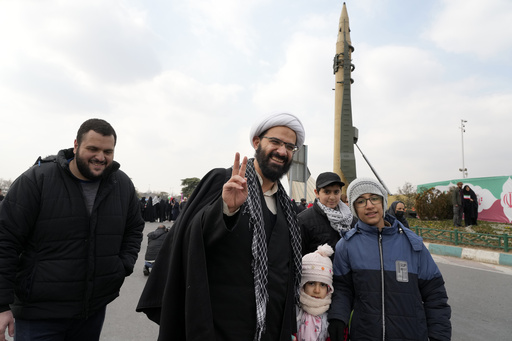
TEHRAN, Iran — The anniversary of Iran’s 1979 Islamic Revolution saw a massive turnout, with tens of thousands of citizens participating in the commemoration. This rally took place amid the backdrop of President Trump’s return to office and the reactivation of his rigorous sanctions campaign aimed at Tehran.
The yearly celebration marks the end of the American-supported Shah Mohammad Reza Pahlavi’s reign and the establishment of Iran’s Shiite theocracy. However, this year’s event occurs during a time of significant instability in the country, where the economy is severely hurt by crushing sanctions. These sanctions threaten to intensify under the current U.S. administration, while Trump has expressed interest in negotiating a deal concerning Iran’s fast-developing nuclear program. On the first trading day of the week, Iran’s rial plummeted to a troubling low of 928,500 rials against the dollar, representing a drop of over 6% since the last trading day.
Supreme Leader Ayatollah Ali Khamenei voiced strong disapproval of any discussions with the United States, branding such negotiations as “not intelligent, wise or honorable.” While he urged against discussions with the U.S. government, he did not outright prohibit engagement with Washington. Meanwhile, Iran’s reformist President Masoud Pezeshkian, who usually advocates for diplomatic outreach, emphasized a more aggressive stance in a speech at Freedom Square in Tehran, characterizing the current situation as a “full-scale economic war.”
“Trump comes and suggests talking, yet simultaneously declares new plots,” Pezeshkian stated. “They propagate claims that the country is weak, while we know we are strong.” He concluded by declaring that Iran would never submit to foreign pressure.
As people marched in freezing temperatures toward Azadi Square, they displayed flags, balloons, and various banners. The crowd’s sentiments were further expressed through slogans advocating for anti-American and anti-Israeli sentiments, such as “Death to America” and “Death to Israel.” Images of Khamenei adorned the gathering, and one demonstrator displayed a sign stating, “We are going to wipe out Israel.” Iran’s military participated by showcasing replicas of its missiles in the square, while some attendees took selfies in front of a truck featuring men in masks of Trump and Israeli Prime Minister Netanyahu behind bars.
Amid the ambient economic challenges, 48-year-old teacher Mohsen Amini articulated his support for the nation, underscoring unity in the face of foreign threats. “I recognize we have serious economic issues, but I am here to reaffirm my commitment to our country regardless of what Trump and the Israelis declare,” he asserted. Hamideh Zamani, a 31-year-old homemaker adorned in a black Islamic chador, attended the event with her children, sharing her belief in unwavering resistance against Western threats. “We will face any challenge from the West without fear. Our fathers taught us to dedicate ourselves to the cause of the Islamic Republic,” she pointed out.
Iranian state television broadcasted live coverage of commemorative events nationwide, encouraging more citizens to participate. The day was honored as a national holiday, granting a festive atmosphere as schools and government offices remained closed, allowing workers to take to the streets in celebration.
The Islamic Revolution was ignited by widespread discontent over the Shah’s reign, culminating in his departure from Iran in January 1979 due to terminal illness. Ayatollah Ruhollah Khomeini’s return from exile led to the fall of the government on February 11, 1979, following extensive protests and conflicts between demonstrators and security forces. In April, the citizens opted to establish an Islamic Republic, resulting in Khomeini becoming the nation’s first supreme leader. The U.S. decision to permit the Shah entry for cancer treatment in New York incited anger, leading to the November 1979 takeover of the U.S. Embassy by militant students, which triggered a 444-day hostage crisis and set the stage for decades of hostility between the two nations.

